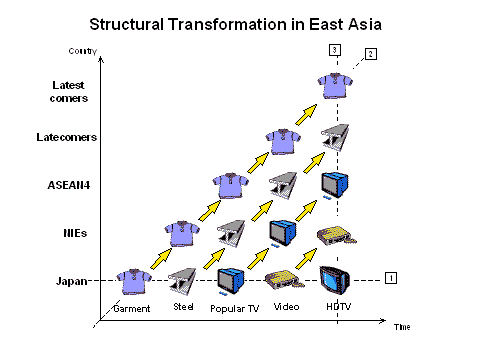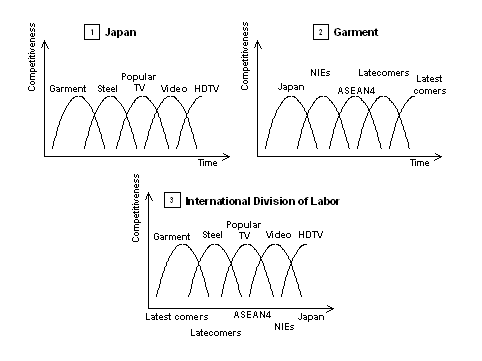|
The Flying Geese Pattern of Development
Dr. Sabro Okita's Presentation
(the 4th Pacific Economic Cooperation Council Conference, Seoul, 1985)
The division of labor in the Pacific region has aptly been called the FG pattern of development..... Traditionally, there have been two patterns or types of international division of labor: the vertical division of labor such as prevailed in the 19th century to define relations between the industrialized country and the resource-supplying country or between the suzerain and the colony; and the horizontal division of labor typified by the EEC with its trade in manufactures among industrialized countries, often among countries at the same stage of development and sharing a common culture. By contrast with both types, the FG pattern represents a special kind of dynamism. In the Pacific region, for example the United States developed first as the lead country. Beginning in the late 19th century, Japan began to play catch-up development in the nondurable consumer goods, durable consumer goods, and capital goods sectors in that order. Now the Asian NICs and the ASEAN countries are following in Japan's footsteps...
Because there is such great variety in the Asian nations' stages of development, natural resource endowments, and cultural, religious, and historical heritages, economic integration on the EEC model is clearly out of the question. Yet it is precisely this diversity that works to facilitate the FG pattern of shared development as each is able to take advantage of its distinctiveness to develop with a supportive division of labor.
Source: Sabro Okita, "Special presentation: prospect of Pacific economies," Korea Development Institute. Pacific cooperation: issues and opportunities (pp.18-29). Report of the Fourth Pacific Economic Cooperation Conference, Seoul, Korea, April 29 -May 1, 1985, p.21.
|

